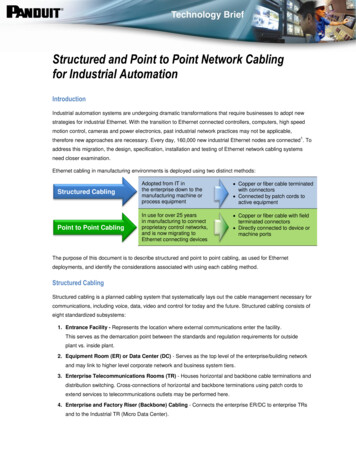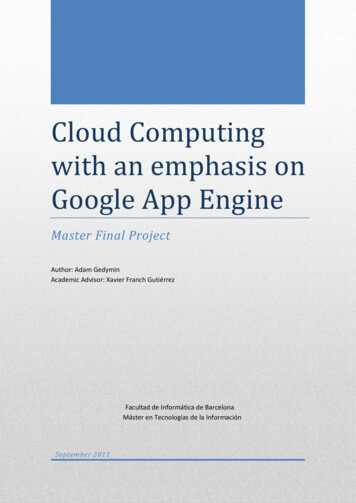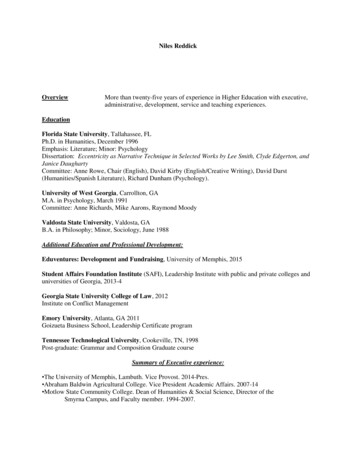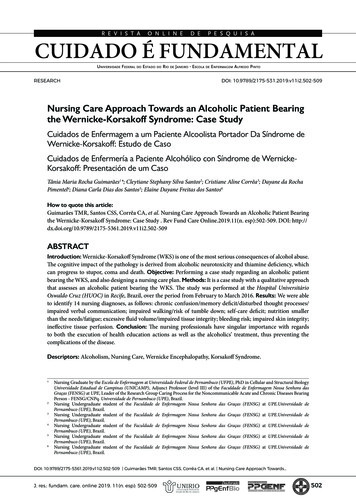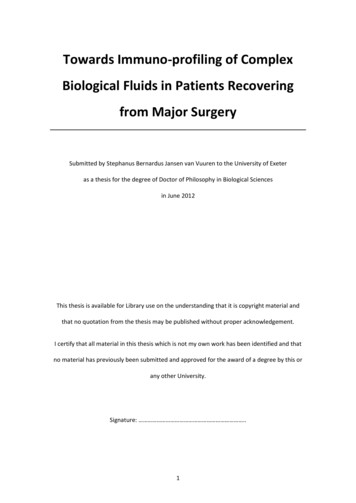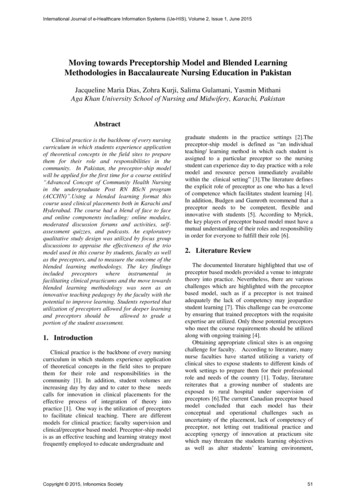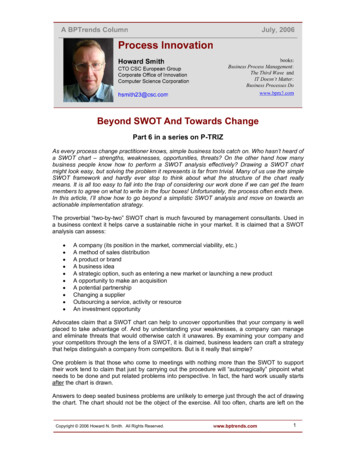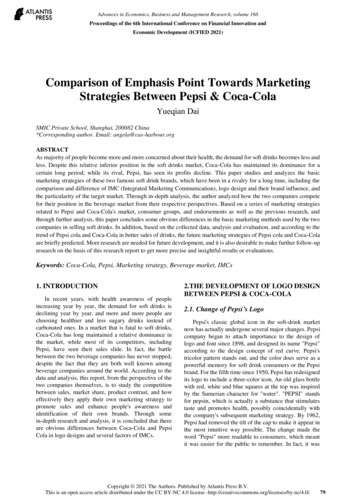
Transcription
Advances in Economics, Business and Management Research, volume 166Proceedings of the 6th International Conference on Financial Innovation andEconomic Development (ICFIED 2021)Comparison of Emphasis Point Towards MarketingStrategies Between Pepsi & Coca-ColaYueqian DaiSMIC Private School, Shanghai, 200082 China*Corresponding author. Email: angela@cas-harbour.orgABSTRACTAs majority of people become more and more concerned about their health, the demand for soft drinks becomes less andless. Despite this relative inferior position in the soft drinks market, Coca-Cola has maintained its dominance for acertain long period; while its rival, Pepsi, has seen its profits decline. This paper studies and analyzes the basicmarketing strategies of these two famous soft drink brands, which have been in a rivalry for a long time, including thecomparison and difference of IMC (Integrated Marketing Communication), logo design and their brand influence, andthe particularity of the target market. Through in-depth analysis, the author analyzed how the two companies competefor their position in the beverage market from their respective perspectives. Based on a series of marketing strategiesrelated to Pepsi and Coca-Cola's market, consumer groups, and endorsements as well as the previous research, andthrough further analysis, this paper concludes some obvious differences in the basic marketing methods used by the twocompanies in selling soft drinks. In addition, based on the collected data, analysis and evaluation, and according to thetrend of Pepsi cola and Coca-Cola in better sales of drinks, the future marketing strategies of Pepsi cola and Coca-Colaare briefly predicted. More research are needed for future development, and it is also desirable to make further follow-upresearch on the basis of this research report to get more precise and insightful results or evaluations.Keywords: Coca-Cola, Pepsi, Marketing strategy, Beverage market, IMCs1. INTRODUCTIONIn recent years, with health awareness of peopleincreasing year by year, the demand for soft drinks isdeclining year by year, and more and more people arechoosing healthier and less sugary drinks instead ofcarbonated ones. In a market that is fatal to soft drinks,Coca-Cola has long maintained a relative dominance inthe market, while most of its competitors, includingPepsi, have seen their sales slide. In fact, the battlebetween the two beverage companies has never stopped,despite the fact that they are both well known amongbeverage companies around the world. According to thedata and analysis, this report, from the perspective of thetwo companies themselves, is to study the competitionbetween sales, market share, product contrast, and howeffectively they apply their own marketing strategy topromote sales and enhance people's awareness andidentification of their own brands. Through somein-depth research and analysis, it is concluded that thereare obvious differences between Coca-Cola and PepsiCola in logo designs and several factors of IMCs.2.THE DEVELOPMENT OF LOGO DESIGNBETWEEN PEPSI & COCA-COLA2.1. Change of Pepsi’s LogoPepsi's classic global icon in the soft-drink marketnow has actually undergone several major changes. Pepsicompany began to attach importance to the design oflogo and font since 1898, and designed its name "Pepsi"according to the design concept of red curve. Pepsi'stricolor pattern stands out, and the color does serve as apowerful memory for soft drink consumers or the Pepsibrand. For the fifth time since 1950, Pepsi has redesignedits logo to include a three-color icon. An old glass bottlewith red, white and blue squares at the top was inspiredby the Sumerian character for "water". "PEPSI" standsfor pepsin, which is actually a substance that stimulatestaste and promotes health, possibly coincidentally withthe company's subsequent marketing strategy. By 1962,Pepsi had removed the tilt of the cap to make it appear inthe most intuitive way possible. The change made theword "Pepsi" more readable to consumers, which meantit was easier for the public to remember. In fact, it wasCopyright 2021 The Authors. Published by Atlantis Press B.V.This is an open access article distributed under the CC BY-NC 4.0 license -http://creativecommons.org/licenses/by-nc/4.0/.79
Advances in Economics, Business and Management Research, volume 166also defined as the first Pepsi logo trend to appearsimplified. During the subsequent changes from 1973 to2008, there was no significant trend change in Pepsi logodesign. By 2008, the PepsiCo brand had changedsignificantly in the way people thought about its logodesign—the combination of ICONS and letters became aleft-right typography, with the tricolor ball on the left andthe "PEPSI" on the right. In an even bigger change,PEPSI has replaced all five letters of its "PEPSI" with alowercase "PEPSI" to present to the public, once againdemonstrating that its logo design is going in thedirection of simplicity. The latest change came in 2014,when Pepsi finally removed the borders of the tricolorspheres, leaving only a simple Mosaic of red, white andblue blocks, taking its icon design to a new, moresimplified level [1].2.2. Change of Coca-Cola’s LogoIn 1887, a year after it came to market, coke'sfounders put a lot of effort into branding, leading to thebrand's first distinctive logo design, a delicate lookdesigned by Frank Mason Robinson that is still incommon use today. With the exception of a singleunsuccessful fairy tale font change in 1890, theCoca-Cola Company has maintained the original design,gradually making it a classic icon rooted in the hearts ofconsumers. This unchanging style reinforces theconcepts of "classic" and "rigid" and occupies anunshakable position among the most loyal fans andconsumers of music. From seeing the logo to thinkingabout the brand to increasing the probability ofconsumption, this chain reaction actually helps theCoca-Cola company to promote any beverage under itsbrand, because people automatically think thatCoca-Cola is the most classic and authentic, and naturalis the best. Unlike Pepsi, the Coca-Cola logo or colordoes not have an extended meaning. However, it may bewise, because undefined means that it is not bound byany concept or meaning, which means it is notrepresented or represented but just Coca-Cola itself [2].2.3. Comparison of Logo Designs between Pepsiand Coca-ColaBoth Coca-Cola and Pepsi have a strong desire todistinguish themselves from other soft drinks companiesin order to increase their visibility without beingconfused by consumers. Because they themselves clearlyunderstand that the competition between the world's twolargest soft-drink companies is a given and will continueindefinitely. Yet when it comes to choosing how torepresent themselves, the two companies clearly havedifferent priorities. The overall trend in Pepsi icon designis an inevitable result of simplicity. First, the word "cola"was removed in 1962, making Pepsi less like its mainrival, Coca-Cola. With more distinctive characters in itsname, Pepsi has been able to create its own brand and tellits own story rather than just being an imitator. After thefirst simplification in 1973, the Pepsi logo was furthersimplified in 2008, leaving only the simplest colorcombinations and lowercase fonts. Coca-Cola, bycontrast, has made only one major change to its logo, thefirst unique handwriting change. It was a wise decisionthat Coca-Cola could not have foreseen, even when theydesigned it. This trademark change allowed it to competesuccessfully with many talented competitors in thebeverage market. To this day, they have adopted andfollowed the special design on the red front, making itdistinctive, people easily remember the logo on the redbackground and white letters, and because of its specialdesign associated with Coca-Cola. Coca-Cola paysattention to its uniqueness and exclusivity in marketing,and the design of its logo is a powerful tool to stabilize itsposition in the soft drink market. As it is expected, CocaCola has become the classic taste in most people's mind,because of its originality and purity, it is easy for peopleto choose to buy it over other brands, which usuallymeans close to the best.3. IMCS OF PEPSIThe utilization of lover brand archetype is what Pepsilong relied on. The use of celebrity, which is a prototypeof lover brand archetype, has always given Pepsi anopportunity to create a "hot topic", whether based onmusicians, sports stars, or any other celebrity. This is notonly because of the benefits of the celebrity's own pullingproducts, but also because there are other motivations topromote the theme of fermentation, making the celebrityand the products they need to promote more influential.Usually, celebrity effect can arouse the emotion andenthusiasm of a specific audience group, which means alarge fan group can arouse the loyalty of theseconsumers, and finally achieve the purpose of promotingsales. Pepsi has long been known for its celebrity hype,which in itself puts a premium on sports stars' fans, whooften number in the millions. In a typical football season,four million fans take part in sporting events outside thefour football clubs.Soft drink is more likely to be a bad product as it is aneconomic term that describes a product in which demanddrops when people's incomes rise. Therefore, thedeclining demand of more and more customers forsugary soft drinks and the increasing demand forlow-sugar or diet drinks as substitutes are bound tobecome the most fundamental future trend of thebeverage market. In recent years, as people's pursuit ofhealth has become more and more intense, the globalpublic demand for low-sugar or zero-sugar drinks is alsoincreasing. This has undoubtedly had a certain impact onthe whole Coca-Cola market. Since Pepsi and coke havebeen substitutes for each other for the majority ofordinary consumers, those who have not formed aninherent habit of drinking a particular type of soft drink80
Advances in Economics, Business and Management Research, volume 166have an obligation, or must, to keep prices within thesame range at all times.3.1. Use of Social MediaThe new use of social media has proved to be quiteambitious and effective in the overall development ofPepsi soft drinks. With the practical application of newsocial media, Pepsi can further develop the youth marketas the youth is always the biggest potential market in thefuture, because each young generation represents thedevelopment space and potential market. There is solidevidence and data to prove the widespread and positiveimpact of Pepsi's new social media (Twitter, hashtag). Byholding these activities and publicity activities on theInternet, Pepsi often has active contact with "netizens",especially young consumers, with the purpose ofpromotion, which naturally reaches the ultimate purposeof publicity. Their potential consumers, those who areinterested in certain activities online, are quick to followthe latest and hottest products, and once Pepsi gets thatattention, it will spread and spread faster than any othermedium. However, always maintaining a highly sensitiveand correct opinion direction is not an easy task. Pepsineeds to be aware of and sensitive to the latest news ortrend models or stars, who may need to keep an eye on orbe exposed to the hottest events [3].3.2. Propaganda for the Concept of HealthOne of PepsiCo's most competitive marketingstrategies in the future is likely to be based on the conceptof health. With increasing awareness of health, more andmore consumers are choosing healthy, low-sugar,non-carbonated drinks. Therefore, adopting this conceptas the main direction of promotion is a fairly accuratedecision in both ethical and commercial aspects. TheLipton brand is the most influential brand under Pepsi,which represents the main promotion concept of Pepsibased on health. Tea itself is a good health drink inpeople's Daily life. Lipton bottled tea, packaged tea andother tea-related products sold in supermarkets or onlinemeet consumers' demand for these healthy drinks.Studies have shown that drinking Lipton tea has 32benefits, including preventing cancer, increasing fluidintake, and improving the immune system. The healthbenefits of Lipton tea add positive value to maintaininghealth and well-being. The Pepsi brand has arguablydone a better job than Coca-Cola at promoting healthydrinks such as tea. Moreover, in a health-consciousworld, more and more people are choosing tea oversugary soft drinks, which has naturally helpedpepsi-Lipton boost sales in the harsh soda market. "Thebig growth that we've observed across our beveragebrands has been around no sugar" explained NatalieRedford, marketing director of PepsiCo UK. "We'rereally unlocking what that means." This shift is beingseen around the globe. Although coke has a larger marketshare, the ratio between Pepsi and coke is not immutable,as people's taste for healthy eating is changing more andmore clearly. People who drink healthier drinks, whichmeans less sugar, or tend to drink tea, opt for morepepsi-branded healthy drinks, such as Pepsi One, AmpEnergy Sugar Free, Aquafina FlavorSplash, LightVanilla. It still has many developing space for developmore diet drinks in the future market for an even broaderrange of customers [3].3.3. The Brand Spirit of Liberty andSpecializationPepsi's latest slogan, "This is what I like," emphasizesand aims at consumers who want to live loudly anddifferently. Pepsi's target consumers are likely to be thosewho have always had a unique or unusual lifestyle orlifestyle, as well as those who have special preferences orpersonalities, especially those who have a tendency toassert their individuality. This kind of excite-seeking andadventurous personality is exactly the message Pepsiwants to send to the masses. Because they are not afraidof being judged positively or negatively by others, theyare likely to live more freely or with more tolerance.Because they do not care, they
the company's subsequent marketing strategy. By 1962, Pepsi had removed the tilt of the cap to make it appear in the most intuitive way possible. The change made the word "Pepsi" more readable to consumers, which meant it was easier for the public to remember. In fact, it was Advances in Economics, Business and Management Research, volume 166
